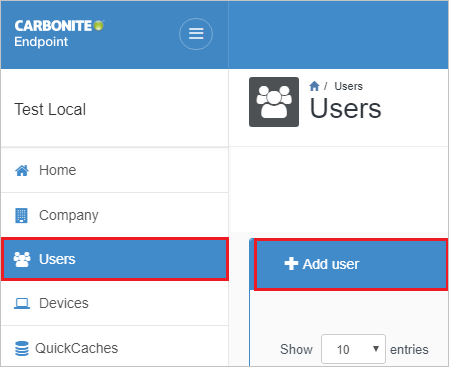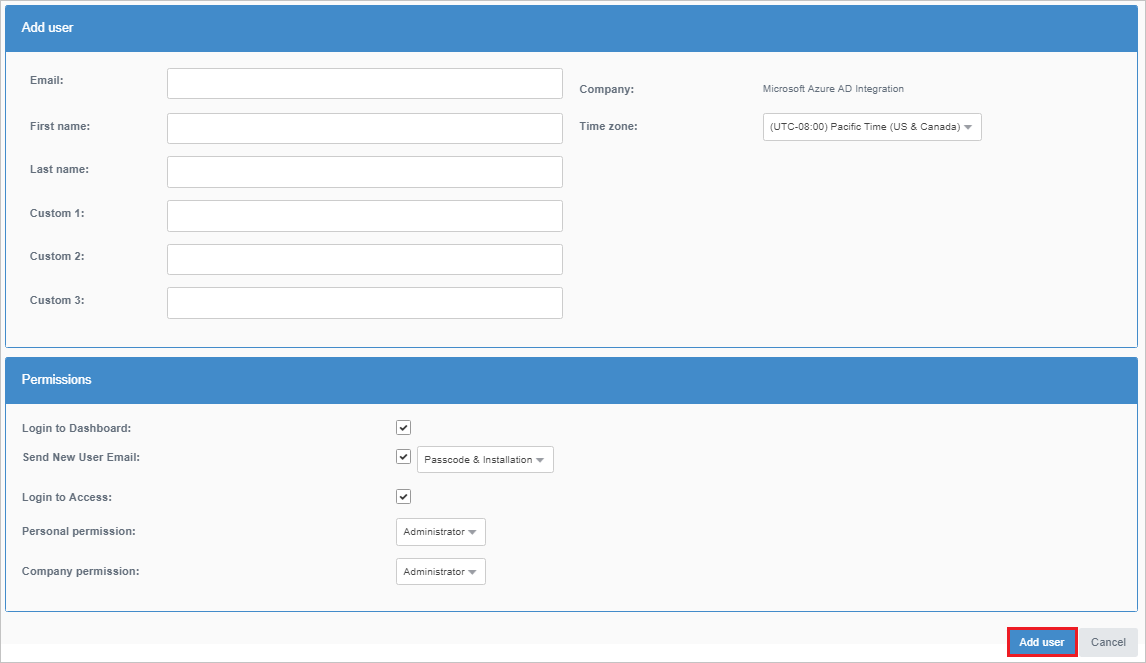Tutorial: Integrate Carbonite Endpoint Backup with Microsoft Entra ID
In this tutorial, you'll learn how to integrate Carbonite Endpoint Backup with Microsoft Entra ID. When you integrate Carbonite Endpoint Backup with Microsoft Entra ID, you can:
- Control in Microsoft Entra ID who has access to Carbonite Endpoint Backup.
- Enable your users to be automatically signed-in to Carbonite Endpoint Backup with their Microsoft Entra accounts.
- Manage your accounts in one central location.
Prerequisites
To get started, you need the following items:
- A Microsoft Entra subscription. If you don't have a subscription, you can get a free account.
- Carbonite Endpoint Backup single sign-on (SSO) enabled subscription.
Scenario description
In this tutorial, you configure and test Microsoft Entra SSO in a test environment.
- Carbonite Endpoint Backup supports SP and IDP initiated SSO.
Note
Identifier of this application is a fixed string value so only one instance can be configured in one tenant.
Add Carbonite Endpoint Backup from the gallery
To configure the integration of Carbonite Endpoint Backup into Microsoft Entra ID, you need to add Carbonite Endpoint Backup from the gallery to your list of managed SaaS apps.
- Sign in to the Microsoft Entra admin center as at least a Cloud Application Administrator.
- Browse to Identity > Applications > Enterprise applications > New application.
- In the Add from the gallery section, type Carbonite Endpoint Backup in the search box.
- Select Carbonite Endpoint Backup from results panel and then add the app. Wait a few seconds while the app is added to your tenant.
Alternatively, you can also use the Enterprise App Configuration Wizard. In this wizard, you can add an application to your tenant, add users/groups to the app, assign roles, as well as walk through the SSO configuration as well. Learn more about Microsoft 365 wizards.
Configure and test Microsoft Entra SSO for Carbonite Endpoint Backup
Configure and test Microsoft Entra SSO with Carbonite Endpoint Backup using a test user called B.Simon. For SSO to work, you need to establish a link relationship between a Microsoft Entra user and the related user in Carbonite Endpoint Backup.
To configure and test Microsoft Entra SSO with Carbonite Endpoint Backup, perform the following steps:
- Configure Microsoft Entra SSO - to enable your users to use this feature.
- Create a Microsoft Entra test user - to test Microsoft Entra single sign-on with B.Simon.
- Assign the Microsoft Entra test user - to enable B.Simon to use Microsoft Entra single sign-on.
- Configure Carbonite Endpoint Backup SSO - to configure the single sign-on settings on application side.
- Create Carbonite Endpoint Backup test user - to have a counterpart of B.Simon in Carbonite Endpoint Backup that is linked to the Microsoft Entra representation of user.
- Test SSO - to verify whether the configuration works.
Configure Microsoft Entra SSO
Follow these steps to enable Microsoft Entra SSO.
Sign in to the Microsoft Entra admin center as at least a Cloud Application Administrator.
Browse to Identity > Applications > Enterprise applications > Carbonite Endpoint Backup application integration page, find the Manage section and select Single sign-on.
On the Select a Single sign-on method page, select SAML.
On the Set up Single Sign-On with SAML page, click the pencil icon for Basic SAML Configuration to edit the settings.

On the Basic SAML Configuration section, if you wish to configure the application in IDP initiated mode, enter the values for the following fields:
a. In the Identifier text box, type one of the following URLs:
https://red-us.mysecuredatavault.com https://red-apac.mysecuredatavault.com https://red-fr.mysecuredatavault.com https://red-emea.mysecuredatavault.com https://kamino.mysecuredatavault.comb. In the Reply URL text box, type one of the following URLs:
https://red-us.mysecuredatavault.com/AssertionConsumerService.aspx https://red-apac.mysecuredatavault.com/AssertionConsumerService.aspx https://red-fr.mysecuredatavault.com/AssertionConsumerService.aspx https://red-emea.mysecuredatavault.com/AssertionConsumerService.aspxClick Set additional URLs and perform the following step if you wish to configure the application in SP initiated mode:
In the Sign-on URL text box, type one of the following URLs:
https://red-us.mysecuredatavault.com/ https://red-apac.mysecuredatavault.com/ https://red-fr.mysecuredatavault.com/ https://red-emea.mysecuredatavault.com/On the Set up Single Sign-On with SAML page, in the SAML Signing Certificate section, find Certificate (Base64) and select Download to download the certificate and save it on your computer.

On the Set up Carbonite Endpoint Backup section, copy the appropriate URL(s) based on your requirement.

Create a Microsoft Entra test user
In this section, you'll create a test user called B.Simon.
- Sign in to the Microsoft Entra admin center as at least a User Administrator.
- Browse to Identity > Users > All users.
- Select New user > Create new user, at the top of the screen.
- In the User properties, follow these steps:
- In the Display name field, enter
B.Simon. - In the User principal name field, enter the username@companydomain.extension. For example,
B.Simon@contoso.com. - Select the Show password check box, and then write down the value that's displayed in the Password box.
- Select Review + create.
- In the Display name field, enter
- Select Create.
Assign the Microsoft Entra test user
In this section, you'll enable B.Simon to use single sign-on by granting access to Carbonite Endpoint Backup.
- Sign in to the Microsoft Entra admin center as at least a Cloud Application Administrator.
- Browse to Identity > Applications > Enterprise applications > Carbonite Endpoint Backup.
- In the app's overview page, select Users and groups.
- Select Add user/group, then select Users and groups in the Add Assignment dialog.
- In the Users and groups dialog, select B.Simon from the Users list, then click the Select button at the bottom of the screen.
- If you are expecting a role to be assigned to the users, you can select it from the Select a role dropdown. If no role has been set up for this app, you see "Default Access" role selected.
- In the Add Assignment dialog, click the Assign button.
Configure Carbonite Endpoint Backup SSO
In a different web browser window, sign in to your Carbonite Endpoint Backup company site as an administrator
Click on the Company from the left pane.

Click on Single sign-on.

Click on Enable and then click Edit settings to configure.

On the Single sign-on settings page, perform the following steps:

In the Identity provider name textbox, paste the Microsoft Entra Identifier value, which you copied previously.
In the Identity provider URL textbox, paste the Login URL value, which you copied previously.
Click on Choose file to upload the downloaded Certificate(Base64) file.
Click Save.
Create Carbonite Endpoint Backup test user
In a different web browser window, sign in to your Carbonite Endpoint Backup company site as an administrator.
Click on the Users from the left pane and then click Add user.

On the Add user page, perform the following steps:

Enter the Email, First name, Last name of the user and provide the required permissions to the user according to the Organizational requirements.
Click Add user.
Test SSO
In this section, you test your Microsoft Entra single sign-on configuration with following options.
SP initiated:
Click on Test this application, this will redirect to Carbonite Endpoint Backup Sign on URL where you can initiate the login flow.
Go to Carbonite Endpoint Backup Sign-on URL directly and initiate the login flow from there.
IDP initiated:
- Click on Test this application, and you should be automatically signed in to the Carbonite Endpoint Backup for which you set up the SSO.
You can also use Microsoft My Apps to test the application in any mode. When you click the Carbonite Endpoint Backup tile in the My Apps, if configured in SP mode you would be redirected to the application sign on page for initiating the login flow and if configured in IDP mode, you should be automatically signed in to the Carbonite Endpoint Backup for which you set up the SSO. For more information about the My Apps, see Introduction to the My Apps.
Next steps
Once you configure Carbonite Endpoint Backup you can enforce session control, which protects exfiltration and infiltration of your organization’s sensitive data in real time. Session control extends from Conditional Access. Learn how to enforce session control with Microsoft Defender for Cloud Apps.
Feedback
Coming soon: Throughout 2024 we will be phasing out GitHub Issues as the feedback mechanism for content and replacing it with a new feedback system. For more information see: https://aka.ms/ContentUserFeedback.
Submit and view feedback for